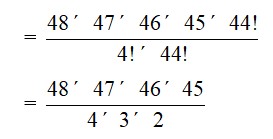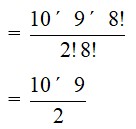Class 11th
Get insights from 8k questions on Class 11th, answered by students, alumni, and experts. You may also ask and answer any question you like about Class 11th
Follow Ask QuestionQuestions
Discussions
Active Users
Followers
New answer posted
6 months agoContributor-Level 10
28. In a deck of 52 cards there are 4 ace cards. The required number of ways of selecting one ace card from the four = 4C1 = = = = 4
After selecting one ace we need to select the remaining 4 card from the remaining 48 card to have a combination of 5 cards. The required number of ways
= 48C4
=

= 1,94,580
Therefore, the total number of ways for selecting 5 card combination out of a deck of 52 cards if there is exactly one ace in each combination
= 4C1*48C4
= 4 * 1,94,580
= 7,78,320
New answer posted
6 months agoContributor-Level 10
27. Since we are to select 3 balls from each colour in order to select 9 balls from the collections of 6, 5 and 5 balls of red, white and blue colours respectively, we can have the combination
6C3 (red) *5C3 (white) *5C3 (blue)
= * *

= 20 * 10 * 10
= 2000
New answer posted
6 months agoContributor-Level 10
26.The number of ways of selecting a team consisting of 3 boys from 5 boys and 3 girls from 4 girls is
5C3*4C3
= *

= *
= 40
New answer posted
6 months agoContributor-Level 10
25. A chord is drawn by connecting 2 points on a circle.
As we are given with 21 points on the circle, we have the following combination to find the number of chords.
New answer posted
6 months agoContributor-Level 10
24. i. 2nC3 : nC3 = 12 : 1
=> ÷ =
=> * = 12
=> = 12
=> = 12
=> 4(2n - 1) = 12(n – 2)
=> 8n – 4 = 12n – 24
=> 24 – 4 = 12n – 8n
=> 20 = 4n
=>n =
=>n = 5
ii. 2nC3 : nC3 = 11 : 1
=> ÷ =
=> * = 11
=> = 11
=> 4(2n – 1) = 11(n – 2)
=> 8n – 4 = 11n – 22
=> 22 – 4 = 11n – 8n
=> 18 = 3n
=>n =
=>n = 6
New answer posted
6 months agoContributor-Level 10
54. Since, the lock can be open by a combination of four digits from the given ten digits I e, from 0 to 9. The number of ways of selecting 4 digits, = 10C4
This combination of 4 digits can again be arranged within themselves in 41 ways. So, total number of

New answer posted
6 months agoContributor-Level 10
53. (a) No. of ways of forming a four-digit number greater than 5000 from the given digit 0, 1, 3, 5, 7. and digit repetition is allowed can be done in such a way either 5 or 7 and occupy the thousands' place and any of the digits 0, 1, 3, 5, 7 can occupy the remaining 3 places.
Hence, the required no. of ways = (2* 5 * 5 * 5) - 1
= 250 - 1 = 249
Here 1 is subtracted because 5000 which can be formed by the permutation of the given digits is not allowed
Hence, n (s) = 249.
Similarly, in order to formed a number divisibleby 5 we need to have either 0 or 5 in the one place.
The required number of ways = 2* 5 *5 *2 - 1
= 100 - 1
= 99
New answer posted
6 months agoContributor-Level 10
23. nC8 = nC2
As, nCa = nCb
=>a = b or a = n – b
=>n = a + b
We have,
nC8 = nC2
=>n = 8 + 2
=>n = 10
Therefore,
nC2
= nC2
=
=
= 45
New answer posted
6 months agoContributor-Level 10
52. Total no. of person selected to represent the company n (s) = 5.
Let A: person is male.
A = {Harish, Rohan, Salim}
n (A) = 3
And B: person has one 35 yes of age.
B = {Sheetal, Salim}
n (B) = 2
And A ∩ B = {Salim}
n (A ∩ B) = 1
Probability that person is either male or over 35 years.
= P (A ∪ B) = P (A) + P (B) P (A ∩ B)
=
Taking an Exam? Selecting a College?
Get authentic answers from experts, students and alumni that you won't find anywhere else
Sign Up on ShikshaOn Shiksha, get access to
- 65k Colleges
- 1.2k Exams
- 679k Reviews
- 1800k Answers


